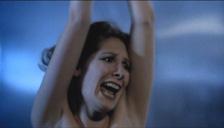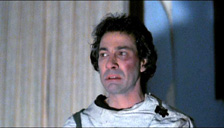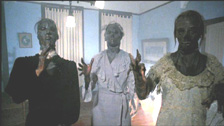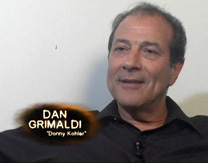Shot independently
in New York and New Jersey in 1979, DON’T GO IN THE HOUSE was released
to drive-ins and grindhouses by Film Ventures International, and did fairly
well at the box office during the early 80s slasher movie craze. Previously
available on VHS from Media Home Entertainment and on DVD from DVD Ltd, Shriek
Show has stepped up to the plate with a definitive version of this gloomy, low
budget shocker.
While working at an incinerator plant, Donny Kohler (Dan Grimaldi) witnesses a co-worker engulfed in flames in a bizarre accident, and does nothing about it but stare into space. Eventually, the fire is extinguished, but Donny is given a bad rap his non actions, with only co-worker Bobby Tuttle (Robert Osth) taking his side and becoming his sole friend. When Donny goes home that night to the large old house he shares with his elderly mother, he discovers her motionless in her chair. With mom now dead, Donny not only leaves her body to rot, but her passing brings out his need to “burn out the evil” (mom used to yank his arms over the stove top fire to discipline Donny). Building a fire proof steal room in the house, Donny brings home attractive women, tying them up naked and blazing them with a flamethrower. During all this slaughter, Donny maintains his friendship with Bobby, but when they meet up at a disco (“disco inferno” is more like it) for a double date, the you know what really hits the fan.
 Certainly
not for every horror fan’s tastes, DON’T GO IN THE HOUSE takes inspiration
from PSYCHO (a crazed, murdering mama’s boy lives in an old house with
mom’s corpse) and also carries the theme of an abused child growing up
to be a very disturbed individual, as in William Lustig’s MANIAC (with
a similar ending), made around the same time. Not in the least overly gory,
shots of naked women being burned alive are technically well carried out, the
three-floor crumbling house sets an appropriately dim atmosphere, and the FRIDAY
THE 13TH-esque music score by Richard Einhorn (SHOCK WAVES, THE PROWLER) is
eerily effective. The movie ranges from being very grim to being unintentionally
laughable with its cast of mostly locals who obviously weren’t professional
actors and did little else film-wise.
Certainly
not for every horror fan’s tastes, DON’T GO IN THE HOUSE takes inspiration
from PSYCHO (a crazed, murdering mama’s boy lives in an old house with
mom’s corpse) and also carries the theme of an abused child growing up
to be a very disturbed individual, as in William Lustig’s MANIAC (with
a similar ending), made around the same time. Not in the least overly gory,
shots of naked women being burned alive are technically well carried out, the
three-floor crumbling house sets an appropriately dim atmosphere, and the FRIDAY
THE 13TH-esque music score by Richard Einhorn (SHOCK WAVES, THE PROWLER) is
eerily effective. The movie ranges from being very grim to being unintentionally
laughable with its cast of mostly locals who obviously weren’t professional
actors and did little else film-wise.
As Donny, Dan Grimaldi carries the entire film, and does a commendable job of it. As soon as he steps on screen, we know there’s something seriously wrong with this guy from his mannerisms, posture, the way he speaks, etc. The clichés of overtly religious overtones, his dead mother beckoning him, as well as another unearthly female voice coaxing Donny are made more convincing by Grimaldi’s performance, which is just right for this film -- never too over the top yet never too ordinary. Grimaldi has had a very successful career since landing this role, and he’s now well known to many for his frequent appearances as Pasquale 'Patsy' Parisi on HBO’s “The Sopranos.”
 Shriek
Show’s DVD of DON’T LOOK IN THE HOUSE is definitely the best the
film ever looked. Presented in its original 1.85:1 aspect ratio with anamorphic
enhancement, colors are very bold, and fleshtones look proper. The image is
very clear, with little in the way of grain and only minor blemishes on the
source print. This is one film that always looked dark and muddy in the past,
but fortunately, that is not a problem here. The mono audio is a little scratchy,
but still sounds fine and serves the film well enough.
Shriek
Show’s DVD of DON’T LOOK IN THE HOUSE is definitely the best the
film ever looked. Presented in its original 1.85:1 aspect ratio with anamorphic
enhancement, colors are very bold, and fleshtones look proper. The image is
very clear, with little in the way of grain and only minor blemishes on the
source print. This is one film that always looked dark and muddy in the past,
but fortunately, that is not a problem here. The mono audio is a little scratchy,
but still sounds fine and serves the film well enough.
A video interview with Grimaldi is included, and he inaugurates it by stating he was no fan of the horror genre after seeing a double bill of DRACULA and FRANKENSTEIN as a child and being very frightened. He tells how he got the role in the film after being discovered in a stage play, and continues on with some more anecdotes. Grimaldi also provides a full audio commentary, and even though there’s no moderator, it’s very thorough and extremely entertaining to listen to. Grimaldi remembers a lot about making it, including some of the technical aspects and special effects, how he got on with the other cast members, the locations and how cold they were, and much more. He does an excellent job of keeping the listener informed about behind-the-scenes stuff, and never runs out of things to say. Other extras include the original theatrical trailer (Film Ventures really knew how to exploit a horror film!) and TV spot, trailers for other Shriek Show releases, and two scenes from the film shown full screen and “unmated.” Explaining that the feature is presented here 1.85:1 as cinematographer Oliver Wood wished it to be, one scene reveals some extra below-the-waist female nudity, while the other is during the disco sequence (this reviewer couldn’t spot anything significantly different for the latter). (George R. Reis)